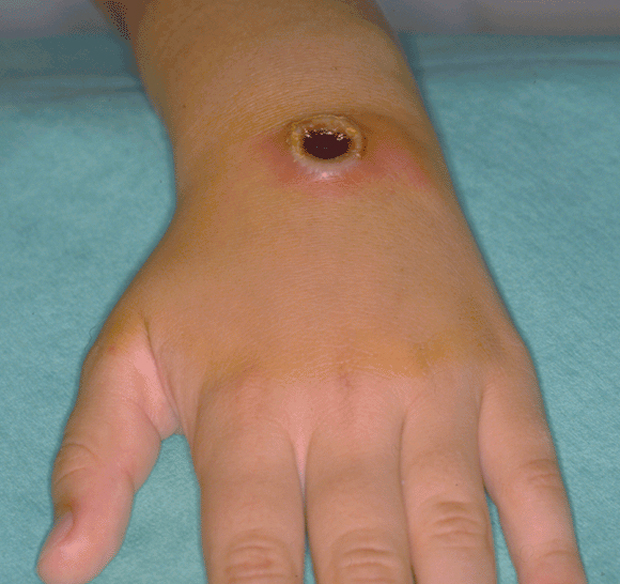MKSAP Quiz: 5-day history of a lesion
A 31-year-old woman is evaluated for a 5-day history of a nonpainful cutaneous lesion on the back of her left hand. She works as a packer in a parcel distribution center. She does not recall injury to this area and reports no unusual employment or recreational exposures. She has not had fever, cough, shortness of breath, headache, chest discomfort, or gastrointestinal symptoms. Yesterday, two coworkers were evaluated for similar lesions. Her husband has recently been prescribed an antibiotic after being diagnosed with a “boil” from which methicillin-resistant Staphylococcus aureus was cultured. Her only medication is an oral contraceptive pill.

On physical examination, vital signs are normal. Other than the lesion on the proximal dorsal surface of her left hand, the physical examination is normal.
The hand lesion is shown.
Which of the following is the most appropriate management?
A. Begin doxycycline, imipenem, and rifampin
B. Begin ciprofloxacin
C. Begin trimethoprim-sulfamethoxazole
D. Obtain biopsy and culture prior to initiating therapy
Answer and critique
The correct answer is B. Begin ciprofloxacin. This question can be found in MKSAP 17 in the Infectious Disease section, item 20.
This patient likely has been exposed to anthrax and should be treated with ciprofloxacin. Although this woman's cutaneous lesion may be a methicillin-resistant Staphylococcus aureus furuncle resulting from contact with her infected husband, the distinctive “coal-like” black eschar, together with similar lesions on two coworkers, requires that anthrax be considered in the differential diagnosis. Oral monotherapy with ciprofloxacin, levofloxacin, moxifloxacin, or doxycycline is recommended as treatment of uncomplicated cutaneous anthrax. Uncomplicated cutaneous anthrax is defined as the absence of systemic symptoms and involvement of the head or neck in the absence of extensive swelling. Moreover, suspicion of any bioterrorism event must immediately be reported to local health authorities.
The addition of one or two preferably bactericidal antibiotic agents is indicated for treating anthrax when systemic disease is clinically suspected or confirmed. Because this patient does not have systemic disease, doxycycline, imipenem, and rifampin are not necessary.
Trimethoprim-sulfamethoxazole (TMP-SMX) is an appropriate antibiotic for treating most methicillin-resistant S. aureus soft tissue infections, but TMP-SMX is not adequate treatment for anthrax because it has unreliable activity.
In cases of suspected bioterrorism, deferring treatment until culture and biopsy results are available could have serious adverse consequences. Untreated cutaneous anthrax is associated with an estimated mortality rate of 10% to 20% because of secondary bacteremic spread. Treatment should be initiated as soon as the diagnosis is suspected.
Key Point
- Uncomplicated cutaneous anthrax should be treated with ciprofloxacin, levofloxacin, moxifloxacin, or doxycycline and should be reported to local health authorities.




